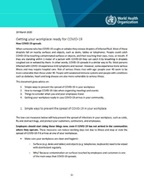
Healthy workplace
Overview
The majority of the world population is in the working-age group. This group spends most of their waking hours at workplaces. Some occupy more than one job to make ends meet. The working population is increasingly adopting sedentary lifestyles, working behind computer screens, sitting at desks, staying in sitting positions most of the time, or standing in the same position for a long duration, especially workers in the service and manufacturing sectors.
Working conditions vary from the service sector to the manufacturing sector, yet sedentary lifestyles, stress at the workplace and unhealthy behaviour persists in all sectors, where workers are unaware of healthy diets, are unable to engage in appropriate physical activities for their physical and mental well-being, or do not have the means to cope with stress and maintain mental health.
The initiative ‘Be the Change’ (BTC) is an innovative intervention launched in the WHO South-East Asia Regional Office in 2016 to promote workplace health and wellness. The initiative offers a variety of options for employees, especially in the areas of diet and physical activity, to improve their physical and mental well-being, and effectively address sedentary lifestyles. Eating healthy, exercising regularly, maintaining a healthy weight, and avoiding alcohol and tobacco are ways of preventing major lifestyle diseases such as cardiovascular disease, diabetes and cancers as well as their risk factors such as raised blood pressure, raised blood sugar level and overweight. However, awareness and practices of these healthy benefits are still low among the population.
